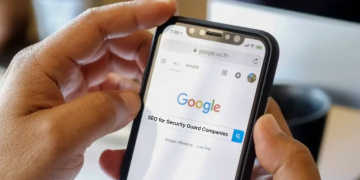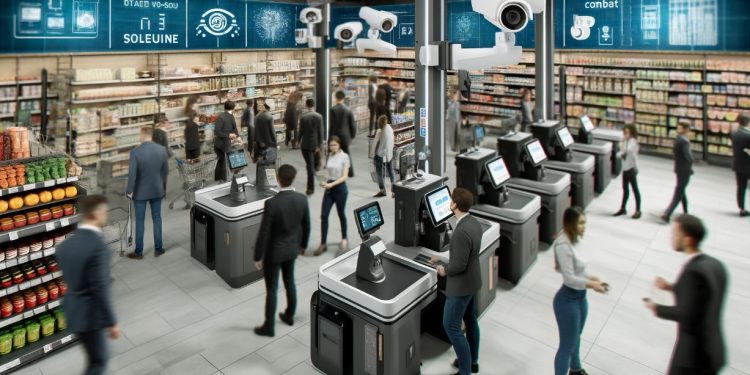Not that long ago, retailers only used front-line retail employees- armed solely with cash registers- to ring up customer’s purchases. But no longer- workplace technologies have rapidly evolved from an employee using a low-tech “calculator-and-a-cash-drawer” cash register tool. Product barcodes, radio frequency identification (RFIDs) with tags and readers, mobile shopping apps, and ultimately self-service kiosks- these are some technologies drastically changing the face of retail. The Point of Sale (POS) customer experience has been transformed.
With increased technology, retailers have a balance to maintain. First they want to offer convenient self-checkout for their customers– that will provide a pleasant and easy shopping experience. Second they must offset that easy self-checkout experience with stringent effective Point of Sale (POS) security measures that prevent shoplifting at self checkout.
Grocery stores, convenience shops, and pharmacies using point of sale (POS) technology are just some of the retailers experiencing an unprecedented rise of brazen self-checkout shoplifting. For instance self-checkout theft statistics indicate that food industries alone are losing more than $10 billion in “shrinkage” annually from their self-checkout machines. Self-checkout and many other factors are contributing to organized retail theft.
How can retailers prevent self-checkout stealing?
First, here’s a brief overview of Point of Sale (POS) technologies. It helps to review these systems and their strengths and weaknesses. This can reveal how stealing from self-service checkouts can happen.
Basic retail Point of Purchase (POP or POS) transactions take place where:
- A merchant calculates the amount owed by the customer (e.g. using weighing scales, barcode scanners, cash registers).
- The amount owed by the customer is indicated with payment terminals, or on touch screens, and coupons or membership discounts can also be calculated.
- Payment options are given to the customer (again with payment terminals or touch screens).
- Receipts for the customer are processed, then the goods are received by the customer.
How to shoplift at self-checkout?
In a recent poll, 69% of self-checkout users thought that the self-check systems made stealing much easier. 15% said that they had purposely committed self-checkout theft. So experienced career shoplifters would have an even deeper understanding of how to shoplift at self-checkout. Here are several standard ways thieves bypass the POS systems:
- The banana trick: Shoplifters punch in a cheaper item’s code (such as a banana) at the kiosk while actually weighing a heavier more expensive item (like a steak).
- The pass around: Shoplifters simply transfer items to the bagging area without scanning them. They trick the weighing scale by placing the unscanned item onto the scale at the same time with another item that they have scanned.
- The switcheroo: The shoplifter switches the barcode of an expensive item with that of a cheaper one. This used to be done by switching barcodes with similar looking items. Now since the main checkout security measure is a scale, it is important to pick items that have similar weight. Shoplifters make sure to pick items that weigh a similar amount in order to fool the self-checkout scale (e.g. passing off prime rib as potatoes- a very big price difference!)
So how do retailers prevent a “point of theft” system, and instead establish a secure POS system?
Retailers are positioning many technological security measures at self-checkout stations to prevent stealing. Here are just some of them:
Surveillance Camera Technology
“CCTV is seen either as a symbol of Orwellian dystopia or a technology that will lead to crime-free streets and civil behavior…” (journalist Heather Brooke)
Security cameras are a mainstay in overseeing self-checkout transactions. Strategically placed cameras such as discreet dome cameras, obvious bullet cameras, or PTZ (pan, tilt and zoom) cameras can cover the self-checkout area, payment terminal, bagging area and exits. Installing cameras in stores for security purposes is fully legal in the US and does not violate privacy laws. California security camera regulations are grounded on the framework of US privacy laws in public spaces. A downside to surveillance camera technology is that someone must be actively watching the cameras to actually stop theft in real time. However, the record of purchases can be used for later investigations (e.g. crime TV shows often use such footage of a suspected killer buying that shovel, tarp and bleach!)
Remote Monitoring And Auditing In Real-Time
Retailers set up a centralized system where multiple self-checkout stations can be remotely visually monitored at the same time. This is real-time oversight, is proactive, and allows loss prevention teams to intervene quickly when suspicious activities are detected. This technology requires trained professionals monitoring and auditing in real-time, and can be expensive.
Missed Scan Detection Technology
“They can see everything you’re purchasing and everything you’re scanning, so I highly recommend not stealing from Walmart…” (former Walmart employee)
Surveillance camera technology has been further fine-tuned through missed scan detection technology, with the self-checkout machine being added into the process. Missed scan detection technology at the register detects unscanned items using camera surveillance. It causes a light to come on above the self-checkout machine, pausing the machine and alerting employees by text as well. Employees approach customers respectfully, and often blame the machine for “accidentally” not scanning the item. If the customer does not want the item, workers take it away. Or they scan it with the customer’s other purchases if they opt to keep it.
Weight Sensing Technology
Weight sensing technology for self-checkout systems detects discrepancies between the weight of scanned items and the actual items. It can be set to provide alerts of discrepancies to loss detection workers that can address potential issues and stop shoplifting.
Rfid And Barcode Scanning
This technology accurately tracks items using Radio Frequency Identification and barcode scanning along with product recognition. It reduces errors and combats shoplifters deliberately switching barcodes among items.
Secure Paymnet Fraud Prevention
Self-checkout systems with secure payment options prevent retailer loss through payment fraud (false or stolen payment information). U.S. retailers lost a total of $60 billion to payment fraud in 2023. Secure pay systems also offer customers trustworthy self-checkout experiences, encouraging more transactions by customers.
New Strategic Legislation Measures To Combat Self-Checkout Theft
One new legislative proposal in California to address the rising problem of self-checkout crime is CA Senate Bill 1446. It would prohibit grocery and drug stores from offering self-checkout options unless certain safety conditions are met. Checkouts would be limited to 10 items or less, at least one manual staffed checkout station must be available, certain items would be prohibited from purchase, an employee could only monitor up to 2 self-service stations, and would be relieved from all other duties while monitoring. Senate Bill 1446 is intended to protect employees from understaffed situations or where shoplifting suspects become aggressors with the employees trying to report them. There are other CA bills being introduced that increase consequences to serial shoplifters and the boosters who sell the stolen goods.















